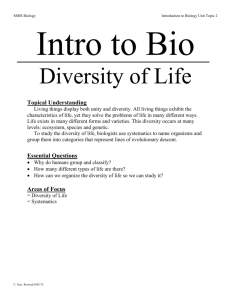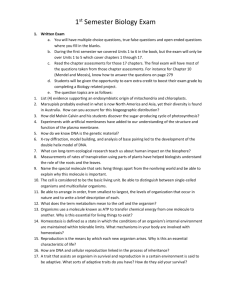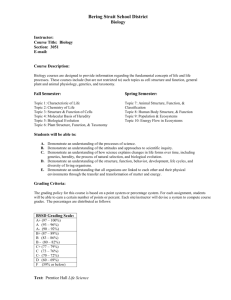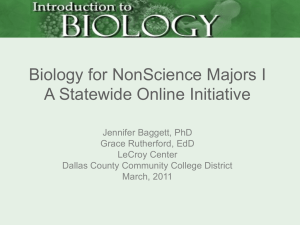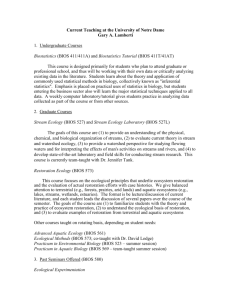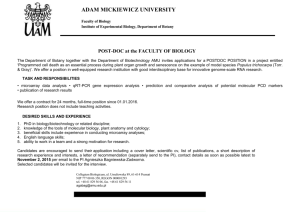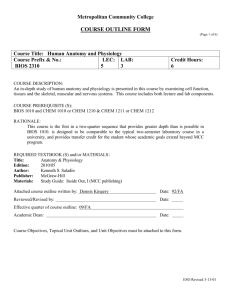BIOS 1111 - Metropolitan Community College
advertisement
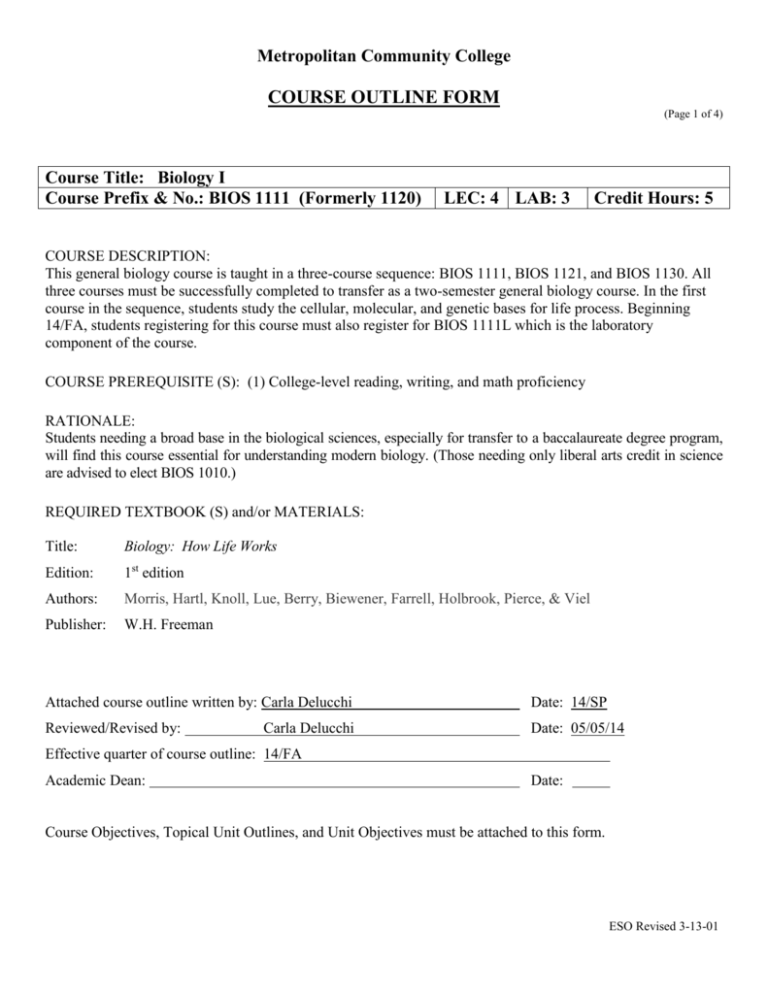
Metropolitan Community College COURSE OUTLINE FORM (Page 1 of 4) Course Title: Biology I Course Prefix & No.: BIOS 1111 (Formerly 1120) LEC: 4 LAB: 3 Credit Hours: 5 COURSE DESCRIPTION: This general biology course is taught in a three-course sequence: BIOS 1111, BIOS 1121, and BIOS 1130. All three courses must be successfully completed to transfer as a two-semester general biology course. In the first course in the sequence, students study the cellular, molecular, and genetic bases for life process. Beginning 14/FA, students registering for this course must also register for BIOS 1111L which is the laboratory component of the course. COURSE PREREQUISITE (S): (1) College-level reading, writing, and math proficiency RATIONALE: Students needing a broad base in the biological sciences, especially for transfer to a baccalaureate degree program, will find this course essential for understanding modern biology. (Those needing only liberal arts credit in science are advised to elect BIOS 1010.) REQUIRED TEXTBOOK (S) and/or MATERIALS: Title: Biology: How Life Works Edition: 1st edition Authors: Morris, Hartl, Knoll, Lue, Berry, Biewener, Farrell, Holbrook, Pierce, & Viel Publisher: W.H. Freeman Attached course outline written by: Carla Delucchi Date: 14/SP Reviewed/Revised by: Date: 05/05/14 Carla Delucchi Effective quarter of course outline: 14/FA Academic Dean: Date: Course Objectives, Topical Unit Outlines, and Unit Objectives must be attached to this form. ESO Revised 3-13-01 Metropolitan Community College COURSE OUTLINE FORM (Page 2 of 4) TITLE: Biology I PREFIX/NO: BIOS 1111 COURSE OBJECTIVES: At the completion of this course, the student will: 1. Understand basic concepts in the biological sciences, particularly regarding the molecular activities of cells, reproduction on a cellular level, and inheritance. 2. Apply these concepts to the solution of problems in familiar or unfamiliar situations. 3. Use higher-level thinking skills in evaluating scientifically-derived information and interpreting cause-and-effect relationships. 4. Evaluate the social consequences of scientific activity. TOPICAL UNIT OUTLINE/UNIT OBJECTIVES: At the completion of this course, students will: THE MOLECULAR BASIS FOR LIFE Explain why some things are considered alive and others are not. Discuss the hypotheses for the origins of life. Demonstrate the use of the scientific method. Explain the basic structures and interactions of molecules and atoms. Describe the structure and function of the major types of organic molecules. Describe the processes used in the central dogma of biology: transcription, and translation. CELL STRUCTURE AND METABOLISM Identify cell structures and their functions. Explain how molecules move into and out of cells. Relate the laws of thermodynamics to living organisms. Explain how enzymes influence chemical reactions. Describe how organisms produce ATP from glucose both when oxygen is present and when it is absent. ESO Revised 3-13-01 Metropolitan Community College COURSE OUTLINE FORM (Page 3 of 4) Describe how photosynthesis is used to create glucose molecules. CELLS AT WORK Describe, compare, and contrast binary fission, mitosis, and meiosis. Explain the differences in cytokinesis between plants and animals. Compare and contrast sexual and asexual reproduction. Explain why and how cells communicate. Describe the process of DNA replication. Describe the methods and uses of manipulation of DNA. Understand the use of electrophoresis to separate different size molecules of DNA. PASSING ON INFORMATION Describe how genomes are sequenced. Explain how DNA packaging differs between prokaryotes and eukaryotes. Describe the types of genome sequences that are not genes coding for proteins. Describe how information found in genomes is used in various areas of biology and medicine. Describe the types of mutations that occur and their effect on organisms. Explain how mutations occur and how organisms repair them. GENETIC CONTROL Describe the genetics of sex determination in a variety of animal species. Work genetics problems including linked genes, X-linked genes, pedigrees, and calculating map distances. Explain how Y-chromosome and mitochondrial DNA are inherited and how this information is used to trace ancestry. Describe the factors that affect complex traits. ESO Revised 3-13-01 Metropolitan Community College COURSE OUTLINE FORM (Page 4 of 4) Explain how twin studies can be used to determine the genetic component of a complex trait. Describe genetic regulation mechanisms in eukaryotes at multiple levels of control. Explain how prokaryotic organisms use operons to control transcription. Explain the importance of differential gene expression in development. COURSE REQUIREMENTS/EVALUATION: Each instructor develops a minimum 1 exam per unit. These exams should include the expectation that students develop skills beyond memorization of facts, e.g., comprehension, application, analysis, synthesis, and evaluation. Students are expected to demonstrate these abilities, at least in part, in writing. At least once per academic year, all sections of this course will be assessed with a multiple choice final exam, with an equal number of questions from each unit. It is expected that for each question 70% of the students will answer correctly. COURSE OBJECTIVES/ASSESSMENT MEASURES COURSE OBJECTIVES MINIMAL ASSESSMENT MEASURES 1. Understand basic concepts in the biological sciences, particularly regarding the molecular activities of cells, reproduction on a cellular level, and inheritance. A closed book unit exam developed by the instructor. 2. Apply these concepts to the solution of problems in familiar or unfamiliar situations. A closed book unit exam developed by the instructor. 3. Use higher-level thinking skills in evaluating scientifically-derived information and interpreting cause-and-effect relationships. A closed book unit exam developed by the instructor. 4. Evaluate the social consequences of scientific activity. A closed book unit exam developed by the instructor. ESO Revised 3-13-01
